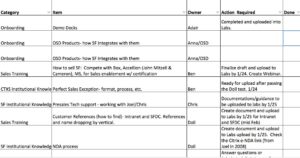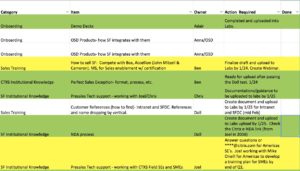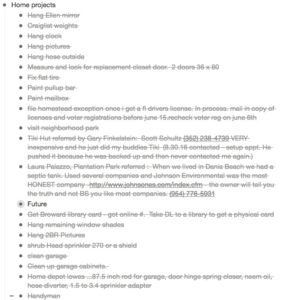 My Mission: Build an Enterprise SAAS sales team and deliver $25M within the next 12 months. (No pressure.)
My Mission: Build an Enterprise SAAS sales team and deliver $25M within the next 12 months. (No pressure.)
I began by selecting one of my current SMB Inside Sales Managers to the lead the team, Joe Volosky. Like everyone else on my team except me, Joe had no experience selling to Enterprise IT. But he was up for the challenge, understood how to sell our product, and had successfully run our SMB sales team for 2 years. We were essentially building an Enterprise team from scratch. He was the right guy for the job.

Creating the Big List
Joe and I met for several hours. We discussed our mission, the expectations for revenue, and our timeline. I began to teach him the differences selling to Enterprise vs. SMB. Then I told him, “We’re going to make a list of every single thing we need to do to build this team and make it a success.”
I created a Google spreadsheet with these 5 columns:
- Category
- Item
- Owner
- Action Required
- Done
Then we populated the Item column with tasks:
- Recruit, Interview and Select Inside Reps.
- Create Demo Decks.
- Create an Enterprise Prospecting Plan.
- Teach ISRs how to Work with Field Reps.
- Structure Demos.
- How to do a Perfect Sales Exception.
- Define a process for working with our Sales Engineer.
- Teach ISRs Perfect Forecasting.
- Customer References (how to find). Tag by vertical.
- Create NDA process.
- Presales Tech Support – who to contact, where to find resources
- Responding to RFPs
- Setup phone systems.
- Create onboarding training for Inside and Field Sales.
- plus about 50 more…
We added more Items throughout the week as we thought of them.
A few days later we met again to assign Owners to each item, to Categorize them and to Prioritize them. By this time, we had about 100 mini-projects.
Joe said, “Man…that is one Big F***ing List.”
From that point forward, our list became known as “the BFL”.

Working the BFL. Over the course of the next 90 days, we worked our way through the projects on the list. Joe and I tackled some of the projects ourselves. We assigned team members to others and then followed up to make sure they were completed. We updated the BFL in real-time (thank you Google Sheets). Every week during our 1-on-1s, we’d review our progress and reprioritize the list as needed.
At the same time, we both had our other jobs to do. I ran our Outbound SMB Sales team and our Inbound Web Sales team. Joe was running the new Enterprise Inside sales team while also learning how to sell to Enterprise SAAS himself.
The BFL became our trusted roadmap that kept us on track.
We never deleted anything from the list. Instead, when an Item was completed, we marked it DONE and Shaded the Row GREEN. Rows in YELLOW were in-progress. Uncolored rows were not yet started.
As the list turned Green, we could measure our progress. It was quite satisfying to see how much we had accomplished each week. It was even more satisfying as we saw real pipeline being created and our deals progressing.
Retiring the BFL
In less than 6 months, we were fully staffed, ISRs were creating pipeline and closing deals, and we had completed nearly every Item on the list (or had decided it was no longer important).
At that point, we retired the BFL. We were now fully focused on running the Enterprise sales team using the Inside Sales Dude methods covered throughout this blog.
I kept a copy of the BFL just so we could look back on it someday. I think I may have referred to the sheer volume of projects Joe completed during his annual review that year. He really grew in that year.
At the end of the year, our team had sold nearly $25M. Mission accomplished.

Other Ways I’ve Used the Big List
I’ve been using different versions of the BFL for over 15 years. Here are some ways I used it:
- To start a blog
- To move cross country 5 times (hopefully I’ll never use it this way again!)
- As my 6 Month plan when I started new jobs as sales rep, sales manager, and VP.
- For major home improvement projects.
- To launch new products.
- To build other sales teams
- To integrate a new acquisition into the parent company
- To start my business, Inside Sales Dude
Tips for using the BFL
- The BFL is ideal for a specific project with a specific goal. It is not intended to be a daily task management or time management list. If you need that, see my 3 Big Rocks series or read the book Getting Things Done.
- If multiple people are involved, create your BFL in Google Sheets, Google Docs, Evernote or some other shared document that everyone can access and update.
- Keep it super simple. The 5 columns I used for the Enterprise BFL is maximum.
- Cross-out (or color code) your completed items but don’t delete them. This way, you won’t ever wonder “Did I forget to add xyz task?”
- Use a tool that you are familiar with. For many of my BFLs, I created a simple numbered list in Word, Google Docs, Evernote, Google Keep, and even on paper.
- I prefer using a software that is accessible on my computer and phone so I can update it anytime from anywhere.
- If you assign a task to someone else, let them run the task as they choose. The BFL should not be used to break down someone else’s tasks into step by step instructions.
- Tackle 1 item at time. When it is completed, mark it DONE or cross it out . Then move to the next item. Over time, you’ll cross out everything.
Next Steps
This one is easy. The next time you have a project, give the Big List method a try. If you do, please drop me a line to let me know how it goes.
Want more like this? Subscribe to receive my newsletter
[mc4wp_form id=”1491″]